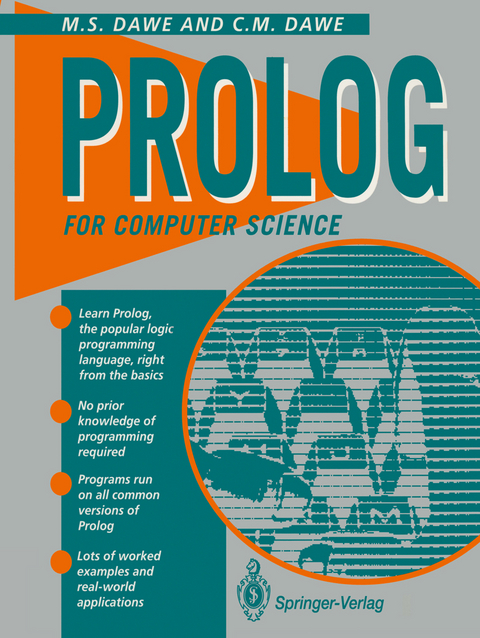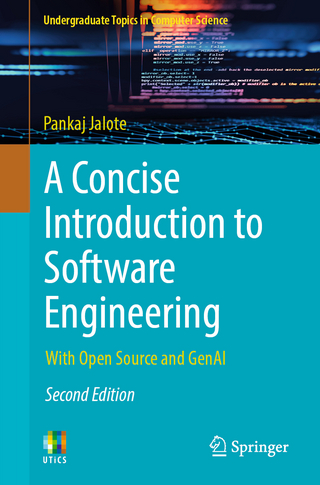PROLOG for Computer Science
Springer Berlin (Verlag)
978-3-540-19811-6 (ISBN)
1 - Prolog.- 1.1 Why Learn Prolog?.- 1.2 Why Use this book?.- 1.3 Prolog.- 1.4 Limitations of Prolog.- 1.5 Past, Present and Future.- 1.6 Accessibility.- 2 - Logic.- 2.1 Introduction.- 2.2 Traditional Logic.- 2.3 Symbolic Logic.- 2.4 Predicate Logic.- 2.5 Deductive Systems in the Real World.- 3 - Logic Programming.- 3.1 Predicate Logic for Prolog.- 3.2 Clauses in Predicate Logic.- 3.3 Resolution.- 3.4 Computation Rules.- 4 - Prolog Syntax.- 4.1 Entering Statements at Prolog's Command Line.- 4.2 Using a Text Editor to Write a Program.- 4.3 Comments.- 4.4 Terms.- 4.5 Predicates.- 4.6 Clauses.- 4.7 Variables.- 4.8 Logical Connectives.- 4.9 Rules.- 4.10 Empty Heads.- 4.11 Making Queries.- 4.12 Built-in Predicates.- 4.13 Operators.- 4.14 Declaring an Operator.- 4.15 Blank Variables.- 4.16 Equality.- 4.17 Recursion.- 4.18 Updating a Running Program.- 4.19 Lists.- 4.20 Applications.- 5 - Goal Searching and Its Control.- 5.1 Goals.- 5.2 Search Control.- 5.3 Extra Search Control Predicates.- 6 - Arithmetic and Mathematics.- 6.1 Introduction.- 6.2 Arithmetic Predicates.- 6.3 Programs Using Arithmetic Predicates.- 6.4 Mathematical Functions.- 6.5 Mathematical Operations.- 6.6 Application.- 7 - Input and Output Predicates.- 7.1 User Interaction.- 7.2 write (term) and read (term).- 7.3 get (Ascii), getO (Ascii) and put (Ascii).- 7.4 tab (I) and ni.- 7.5 name (atom, code).- 7.6 Using Data Files.- 7.7 Controlling the Input and Output Streams.- 8 - Data Structures.- 8.1 Introduction.- 8.2 Lists.- 8.3 Operations on Lists.- 8.4 Semantic Networks.- 8.5 Frames.- 8.6 If ... Then ... Rules.- 9 - Preventing and Removing Program Errors.- 9.1 Introduction.- 9.2 Errors in the Modelling Process.- 9.3 Syntax Errors.- 9.4 Type Testing of Terms.- 9.5 More on Type Testing.- 9.6Programming Style.- 9.7 Errors Due to Search Control.- 9.8 Debugging.- 10 - Natural Languages.- 10.1 Parsing.- 10.2 An English to Dutch Translator.- 11 - Philosophical Issues.- 11.1 Introduction.- 11.2 Machine Intelligence.- 11.3 Empirical Significance.- 12 - Parallel Processing Prolog.- 12.1 Parallel Processing.- 12.2 Parallel Processing for Prolog.- Appendix 1.- Dictionary of Built-in Predicates.- Appendix 2.- Glossary of Terms.- Appendix 3.- Common Error Statements.- Appendix 4.- ASCII Codes.- Appendix 5.- List of Operator Precedences.- Appendix 6.- Prolog Versions.- Appendix 7.- Further Reading.- Appendix 8.- Leashing Directory.- References.- Answers to Selected Questions.
| Erscheint lt. Verlag | 4.11.1994 |
|---|---|
| Zusatzinfo | XII, 189 p. 1 illus. |
| Verlagsort | London |
| Sprache | englisch |
| Maße | 210 x 280 mm |
| Gewicht | 372 g |
| Themenwelt | Mathematik / Informatik ► Informatik ► Programmiersprachen / -werkzeuge |
| Informatik ► Theorie / Studium ► Compilerbau | |
| Schlagworte | Computer Science • data structures • Debugging • Functions • Logic • Logic Programming • Mathematica • NATURAL • Processing • programming • Programming language • PROLOG • Resolution • Variable |
| ISBN-10 | 3-540-19811-3 / 3540198113 |
| ISBN-13 | 978-3-540-19811-6 / 9783540198116 |
| Zustand | Neuware |
| Informationen gemäß Produktsicherheitsverordnung (GPSR) | |
| Haben Sie eine Frage zum Produkt? |
aus dem Bereich




